 |
Convert H264 to OGV
|
Total Video Audio Converter converts H264 files to OGV quickly. With
a simple and user-friendly interface, Total Video Audio Converter makes H264 to OGV
conversion quite easy, and helps you to embed
video on your website using HTML5 easily.
Total Video Audio Converter is a professional and easy-to-use video Converter Software
that converts video files at fast speed and high quality. The software converts
any formats to popular video formats such as H.264, CAF (Core Audio Format), VCD, SWF, Xvid, DTS, OGM, etc.
It could convert FLV to Xvid, RM to BMP image sequence, FLV to DTS, H263 to TIFF image sequence, WebM to Android Tablet, and so on.
Total Video Audio Converter supports batch conversion and, is full compatible
with 32-bit and 64-bit editions of Windows 10/8/7/Vista/XP/2000.

What is H264?
H.264/MPEG-4 Part 10 or AVC (Advanced Video Coding) is a standard for video
compression, and is currently one of the most commonly used formats for
the recording, compression, and distribution of high definition video.
For temporal bitstream scalability (i.e., the presence of a sub-bitstream
with a smaller temporal sampling rate than the main bitstream), complete
access units are removed from the bitstream when deriving the sub-bitstream.
However, the latest quad-core general-purpose x86 CPUs have sufficient
computation power to perform real-time SD and HD encoding. Specified in
Annex H of H.264/AVC, MVC enables the construction of bitstreams that represent
more than one view of a video scene. The CCTV (Closed Circuit TV) and Video
Surveillance markets have included the technology in many products. HTML5
is being developed by the HTML5 working group as an open standard to be
adopted by all web browser developers. Main Profile (MP): This profile
is used for standard-definition digital TV broadcasts that use the MPEG-4
format as defined in the DVB standard. It is not, however, used for high-definition
television broadcasts, as the importance of this profile faded when the
High Profile was developed in 2004 for that application. The final drafting
work on the first version of the standard was completed in May 2003. In
early 1998, the Video Coding Experts Group (VCEG - ITU-T SG16 Q.6) issued
a call for proposals on a project called H.26L, with the target to double
the coding efficiency (which means halving the bit rate necessary for a
given level of fidelity) in comparison to any other existing video coding
standards for a broad variety of applications.
What is OGV?
OGV is a video container that uses the Ogg Vorbis audio container. In addition,
the OGV file contains different types of codecs for video streaming (live
video) such as Theora or DivX. Only a few media players support OGV files.
Further work on adaptive quantization, as well as overall detailed subjective
tuning of the codec, is still to come. Theora is a variable-bitrate, DCT-based
video compression scheme. Like most common video codecs, Theora also uses
chroma subsampling, block-based motion compensation and an 8-by-8 DCT block.
Pixels are grouped into various structures, namely super blocks, blocks
and macroblocks. Theora scales from postage stamp to HD resolution, and
is considered particularly competitive at low bitrates. It is in the same
class as MPEG-4/DiVX, and like the Vorbis audio codec it has lots of room
for improvement as encoder technology develops. The Theora I Specification
was completely published in 2004. Any later changes in the specification
are minor updates. It began as a 2006 Google Summer of Code project, and
it has been developed on both the Nios II and LEON processors. Theora is
an open and royalty-free lossy video compression technology being developed
by the Xiph.Org Foundation as part of their Ogg project. Based upon On2
Technologies' VP3 codec, Theora competes with MPEG-4, WMV, and similar
low-bitrate video compression schemes. Theora is well established as a
video format in open source applications, and is the format used for Wikipedia's
video content. However, the proposed adoption of Theora as part of the
baseline video support in HTML5 resulted in controversy. A flaw in the
version of FFmpeg used in the test initially led to incorrect reports of
Theora PSNR surpassing that of H.264.
How to Convert H264 to OGV?
- Free Download Total Video Audio Converter
- Install the Program by Step-by-step Instructions
- Launch Total Video Audio Converter
- Choose H264 Files

Click "Add Files" to choose H264 files.

Choose one or more H264 files you want to convert and then click Open.
Total Video Audio Converter will open the files and get file
information such as width, height, frame rate, video bit rate, audio sample rate,
audio bit rate, audio channels, and then list the information at conversion list.
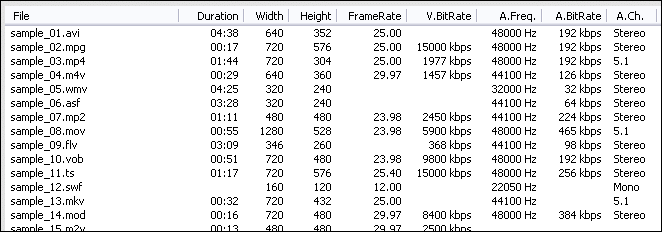
- Choose Output Format
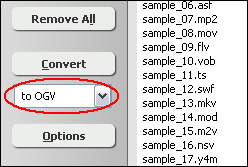
Click on combo box of output format and then choose "to OGV".
- [Optional, for advanced user]
Set Encoding Parameters
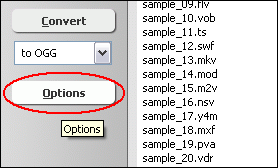
If you want to change OGV encoding parameters such as bit rate, frame rate, video
size, please click "Options".
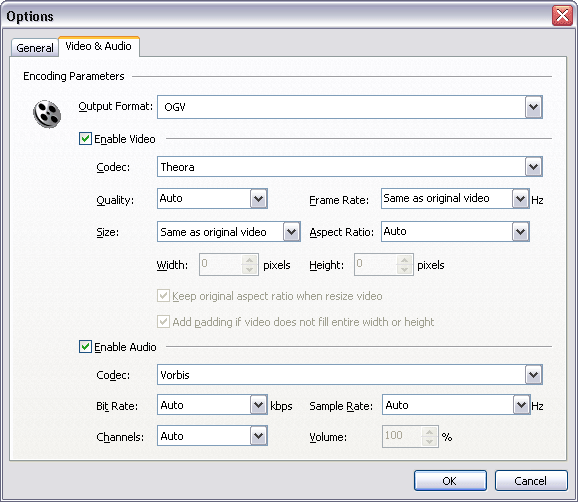
And then, switch to tab "Video & Audio" and then set options.
- Convert H264 to OGV
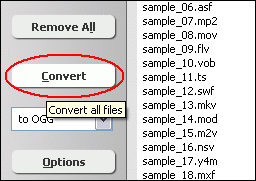
Click "Convert" to convert all H264 files in list to OGV format.

The software is converting H264 files to OGV.
- Play & Browse
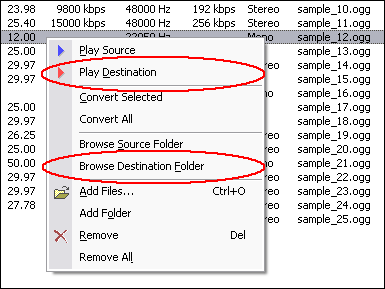
When conversion completes, you can right-click converted item and choose "Play
Destination" to play the outputted OGV file; or choose "Browse Destination
Folder" to open Windows Explorer to browse the outputted OGV file.
- Done
Top
H264 to OGV Software is 100% clean and safe to
install. It's certified by major download sites.

Convert H264 to OGV Related Topics:
|











